Choosing a bicycle helmet to buy can be a tough decision these days.
As cyclists, we want our helmet to be good-looking, lightweight, aero, low profile, provides plenty of ventilation, and comes with the most advanced safety features for maximum head protection.
Sounds like quite a bit of hard work.
A Quick Glance : Our Favorite Road Cycling Helmets
Editor’s Pick : Giro Cinder
“Packs many safety features including MIPS liner in a budget-friendly helmet.”
Best Design : Kask Protone
“A classy and timeless design that withstood the test of time.”
Best Lightweight : Kask Valegro
“Lightweight with 37 air vents for hot days in the high mountains.”
Value for Money Picks
Giro Cinder MIPS
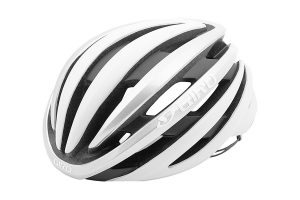
The Giro Cinder is my pick as it packs many safety features in a budget-friendly way.
It’s a great alternative to its premium sibling, the Giro Synthe and the Giro Aether. Despite this impressive safety technologies, the Giro Cinder doesn’t put on much extra weight and comes in at 290g for Medium. The buttery smooth Roc Loc 5 dial retention system keeps it locked on your head without you even knowing it’s there.
Giro’s decision to use in-mold polycarbonate for its shell allows for the addition of 26 massive Wind Tunnel vents with internal channels that route air over your head and out through the exhaust at the back of the helmet. This makes it a very well-ventilated.
Lastly, it is ponytail compatible (great for female road cyclist), an often overlooked feature that I’m happy to see integrated into this fantastic CPSC-certified helmet.
- Pros : Budget price and comes with MIPS system.
- Cons : Larger sizes can be heavy compared to their peers.
Bell Stratus MIPS
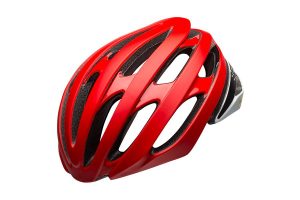
The Bell Stratus MIPS offers cyclists incredible safety at a great price point.
It sits one range below the premium Bell Zephyr which is known for its minimalist looks. Utilizing the Bellʼs Float Fit system, the retention system helps keep it snug yet comfortable on your head. It weighs in at only 275g for a size Medium. You won’t even feel it’s there!
Safety-wise, the MIPS system integration, and CPSC compliance make the Bell Stratus MIPS a great choice for road cyclists at all levels. If you’re riding in the summer, the Bell Stratus is one that you’d want to have with its 18 vents!
- Pros : Very well ventilated for hot summer days.
- Cons : Gloss surface is prone to fading when exposed to sun overtime.
Kask Mojito 3
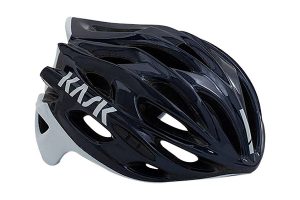
The Kask Mojito has been around for a long time, since 2012 when Bradley Wiggins wore it en route to winning the Tour de France.
It used to be Kask’s top-of-the-line helmet but has since been bumped down to mid-tier. 8 years on, it continues to be a popular choice among road cyclists. It recently went through a minor update to improve the fitting and comfort, and it’s now called the Mojito 3
At 230g, the Mojito is very light and comes with great ventilation with 26 vents to keep your head cool during the hottest summer days. If you’re a big fan of Kask and the premium Kask Protone is out of your budget, give the Mojito X a serious consideration.
- Pros : 26 vents to keep your head cool and high-quality leather chin strap.
- Cons : One of a handful of models that don’t come with MIPS.
Lazer Genesis MIPS
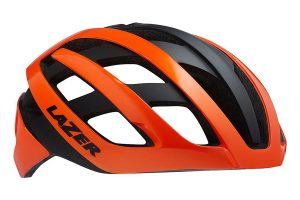
One look at the Lazer Genesis, and you’ll understand why we’ve given it a five star rating for great ventilation.
Lazer has been designing and manufacturing helmets for all manner of biking since its launch in 1919. The Genesis is one of its high-end designs.
The vents are huge and numerous, with 22 openings. It is well ventilated, to say the least. The Lazer Genesis MIPS is also one of the lighter models you’ll find, with a weight of just 230g for a Small size.
Ventilation and weight savings aren’t the only focus here. The Lazer Genesis uses MIPS for protection against rotational impacts. It also features Lazer’s Advanced Rollsys fit system, which allows for horizontal and vertical adjustment.
- Pros : Very breathable with 22 air vents.
- Cons : Limited color choices.
Good Looking Picks
Kask Protone
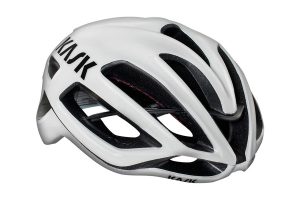
The Kask Protone is, quite simply, a perfect helmet. Our team gives it a five star rating for its design.
Previously, cyclists were told to pick two between weight, aerodynamics, and ventilation. With the Kask Protone, you have all three.
In fact, it’s also one of the coolest helmets around today. Weighing in at a mere 215g for Medium, it manages to be light while delivering features some would only expect from a much heavier, clunkier bike helmet.
Kask wind-tested the Protone with Team Sky riders and has been Chris Froomeʼs bike helmet of choice since its introduction. You can still see them wearing the Protone at the Tour de France today.
Because of its versatility, the Kask Protone can be spotted on riders doing anything from flat time trial to above category climbs deep in the Alps.
- Pros : Elegant and timeless design.
- Cons : Expect to pay a premium especially for the white color model.
MET Trenta 3K Carbon
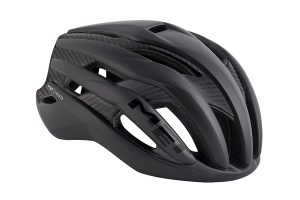
The MET Trenta 3k Carbon one of the lightest helmets you can buy at 215g.
It’s nice to know your helmet is there to protect your noggin while at the same time not being constantly reminded that you’re wearing it because of its weight. That’s the effect that the MET Trenta 3K Carbon has. You’ll barely know it’s there.
MET uses polystyrene that is less dense to lighten the load, then imbeds woven carbon into the shell to maintain strength. In addition to being lightweight, MET also claims that the Trenta 3K Carbon is as aerodynamic as an aero helmet when in the drops and 7% faster than any helmets when on top of the handlebars.
This is the same helmet Tadej Pogacar wore to win the 2020 and 2021 Tour de France.
- Pros : Lightweight and stylish design.
- Cons : Expensive.
Specialized S-Works Evade
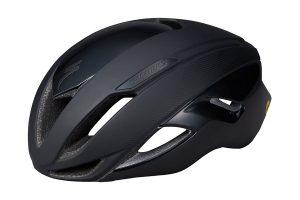
If Specialized is putting S-Works, its premium product line on this, you know it must be one heck of a bike helmet.
Specialized said the S-Works Evade is quite simply the fastest road bike helmet it has ever tested. In fact, the company said it is almost as aerodynamic as its S-Works TT helmet. This is a testament to the company’s intensive airflow testing and safety tech. But aerodynamics isn’t the only thing the S-Works Evade features.
As the company says, aerodynamics wouldn’t mean a whole lot if your head was roasting in it. As such, it is designed to be one of the coolest on the market as well.
- Pros : ANGi Crash sensor system notifies your emergency contact in event of a crash and sends them to your GPS coordinates.
- Cons : Expect it to come with a premium price tag.
Lazer Bullet 2.0
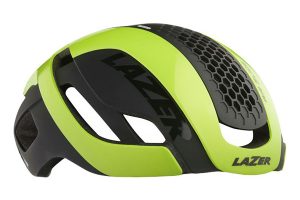
If you’re looking for an aero helmet, then you’ll love the futuristic Bullet 2.0 from Lazer.
This may be the first aero helmet that is adjustable for aerodynamics and ventilation. The Bullet 2.0 is outfitted with Lazer’s Airslide system. Burning up on a climb?
Adjust the Airslide system to create airflow through front ventilation holes and rear exhaust system. Need maximum aerodynamics on a flat or downhill? Close the vents for a fully closed cap. And there’s more.
It is compatible with an Inclination Sensor, which monitors your head position on the bike. It even has your eyewear covered. The Lazer Bullet includes its own magnetic aerodynamic lens that fits onto the front.
- Pros : Futuristic design with many color choices.
- Cons : Magnetic lens is sold separately.
Lightweight Picks
Kask Valegro
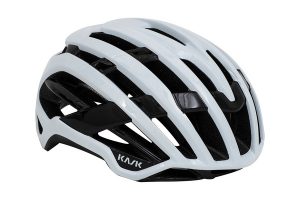
The Kask Valegro, which you might have first seen on the heads of Team Sky riders back in 2017, with an impressive weight of 180g.
A lightweight helmet doesn’t have to mean unsafe, and that’s certainly the case with Kask’s Valegro. It features a whopping 37 vents for great ventilation and quick-dry pads that wick away moisture.
Of course, the lightweight qualities wouldn’t mean much if it wasn’t safe. It protects your head with a polycarbonate shell that covers both the top as well as the base ring.
The Kask Valegro also features Kask’s Octo Fit adjustment dial, which is easy to adjust to fit any head sizes and head shapes.
- Pros : Super lightweight and great ventilation.
- Cons : Fitting can be tricky for some.
POC Ventral Air SPIN
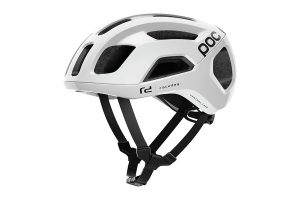
The POC Ventral Air SPIN takes characteristics from its popular Octal and Ventral designs to give it enhanced ventilation and aerodynamics.
It is designed with channels that allow air to pass through as quickly and efficiently as possible at high or low speeds. The result is optimal cooling for your noggin in a lightweight helmet.
As with all of POC’s helmets, the POC Ventral Air incorporates the company’s SPIN (Shearing Pad INside) crash technology into its design. It will rotate in the event of a crash, minimizing direct impact and protect your head.
The POC Ventral Air SPIN is also outfitted with silicone pads for additional safety and comfort.
- Pros : Sleek looking helmet design and many color options to choose from.
- Cons : Straps are flimsy.
Giro Aether MIPS
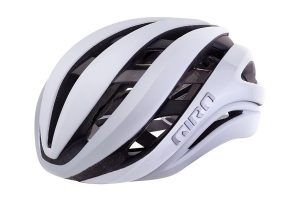
The folks at Giro have always been known as innovators when it comes to making lightweight and good-looking bike helmets.
This Giro Aether MIPS is no different. It offers the best protection you’ll find in a bicycle helmet while not compromising the weight, ventilation, and aerodynamics that competitive road racing demand.
The Giro Aether features MIPS spherical technology, which uses a plastic liner to allow the helmet to slide around the head to redirect impact forces in the event of a crash. Giro adapts this safety tech by putting two layers of EPS foam on the outside of the polycarbonate shell in order to create the MIPS effect.
This replaces the plastic liner that inhibits airflow and limits ventilation. The Giro Aether MIPS features 11 large vents, meaning it is not only safe but also very cool.
- Pros : Perfect balance between safety features, ventilation, and good looks.
- Cons : Expect to pay premium pricing.
Bell Z20 MIPS
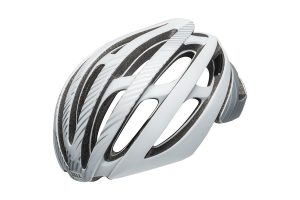
With decades of experience manufacturing helmets for the masses, Bell has integrated all of those into their flagship model, the Bell Z20.
The Bell Z20 takes a low-profile design approach. It has a good-looking, minimalist look. By staying close to the head, the Bell Z20 gives the rider a sleek appearance that one might even call a pro.
At 280g for size Medium, the Bell Z20 isn’t the lightest on this list, but it’s certainly the most feature-rich. Bell stopped at nothing to create a balanced helmet with equally strong performance aerodynamics, ventilation, and safety characteristics.
Their Float Fit Race fit system cradles your head in such a way that you’ll quickly forget it’s there, even if you’re suffering up the last climb of the day. Speaking of climbing, you’ll be happy to know that their ventilation system works wonders even at low speeds.
- Pros : Low profile and aero design.
- Cons : Heavier than similarly priced models.
How We Pick Bike Helmets
If you look around, you will quickly realize that there are hundreds of options out there today. In order to filter out and shortlist the best ones, we turned to online cycling forums, asking around in bunch rides and scouring Instagram and Facebook influencer feeds to get first-hand experience.
We also complement this by going through the user reviews on large online retailers such as Amazon, Competitive Cyclist, and Amazon.
In picking our favorite models, we focused on five objective criteria below :
- Price. Bicycle helmet pricing varies across the board. There are some that have top-notch safety features such as MIPS technology but don’t cost you a limb. On the other hand, there are also nice-looking, lightweight ones that will cost you more. Cheap doesn’t always mean it’s not safe.
- Safety features such as MIPS and SPIN technology are very common in helmets across all price points these days. They provide additional protection especially if you fall in an awkward position.
- Safety standards. Make sure the helmet is certified. Each region (eg: United States, Europe, or Australia) has a different set of certification criteria. You’ll see stickers such as CPSC (Consumer Product Safety Commission), CE, or AU/NZS depending on where you’re located.
- Fit and comfort. The shape of your skull dictates which one will work best for you. Generally, a particular brand will have a very similar skull fit across most of its helmet lineup. If you’re switching between brands, it’s better to try them out at the stores first.
- Breathability. We made sure that all the helmets we pick are highly breathable. The more vents (or the bigger) there are, the more breathable a helmet is.
You can read more in our helmet buying guide here.

